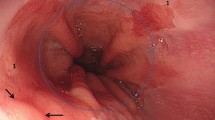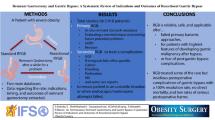Abstract
Background
The main concerns following sleeve gastrectomy (SG) include the risk of gastroesophageal reflux disease (GERD) and its complications, such as Barrett’s esophagus (BE). However, there is conflicting data on esophageal conditions, and studies on alterations of gastric mucosa after SG are lacking, despite reported cases of gastric cancer. Our aim was to assess esophageal and gastric lesions after SG.
Methods
From November 2017, an upper gastrointestinal endoscopy (UGE) was proposed at least 3 years after SG to all patients operated on in our institution. Endoscopic results and gastric histological findings were analyzed. BE was defined as endoscopically suspected esophageal metaplasia with histological intestinal metaplasia.
Results
Between September 2008 and August 2018, 375 patients underwent SG at our institution, of which 162 (43%) underwent at least one UGE 3 years or more after SG (91% women, mean preoperative age: 43.3±10.3 years). Despite a significant increase in the prevalence of symptomatic GERD, hiatal hernia, and esophagitis after SG (p<0.001 vs. preoperatively), no cases of BE were detected. Gastric dysplasia was not found and the prevalence of gastric atrophy tended to decrease after SG. However, 27% of patients with gastric biopsies developed antral reactive gastropathy.
Conclusions
At a mean follow-up of 54 months after SG, no BE or gastric dysplasia was identified. However, reactive gastric lesions appeared, and their long-term consequences need to be further clarified. Thus, the timing of endoscopic follow-up, starting as early as 3 years after SG should be reevaluated to improve patient adherence with long-term endoscopies.
Graphical Abstract



Similar content being viewed by others
Data Availability
The data that support the findings of this study are available on request from the corresponding author.
References
Carlsson LMS, Sjöholm K, Jacobson P, et al. Life Expectancy after Bariatric Surgery in the Swedish Obese Subjects Study. N Engl J Med. 2020;383(16):1535–43.
Angrisani L, Santonicola A, Iovino P, et al. Bariatric Surgery Survey 2018: Similarities and Disparities Among the 5 IFSO Chapters. Obes Surg. 2021;31(5):1937–48.
Coupaye M, Rivière P, Breuil MC, et al. Comparison of nutritional status during the first year after sleeve gastrectomy and Roux-en-Y gastric bypass. Obes Surg. 2014;24(2):276–83.
Coupaye M, Gorbatchef C, Calabrese D, et al. Gastroesophageal Reflux After Sleeve Gastrectomy: a Prospective Mechanistic Study. Obes Surg. 2018;28(3):838–45.
Spechler SJ, Souza RF. Barrett's esophagus. N Engl J Med. 2014;371(9):836–45.
Hvid-Jensen F, Pedersen L, Drewes AM, et al. Incidence of adenocarcinoma among patients with Barrett’s esophagus. N Engl J Med. 2011;365(15):1375–83.
Sharma P. Barrett Esophagus: A Review. JAMA. 2022;328(7):663–71.
Brown WA, Johari Halim Shah Y, Balalis G, et al. IFSO Position Statement on the Role of Esophago-Gastro-Duodenal Endoscopy Prior to and after Bariatric and Metabolic Surgery Procedures. Obes Surg. 2020;30(8):3135–53.
Campos GM, Mazzini GS, Altieri MS, et al. Clinical Issues Committee of the American Society for Metabolic and Bariatric Surgery. ASMBS position statement on the rationale for performance of upper gastrointestinal endoscopy before and after metabolic and bariatric surgery. Surg Obes Relat Dis. 2021;17(5):837–47.
Fisher OM, Chan DL, Talbot ML, et al. Barrett's Oesophagus and Bariatric/Metabolic Surgery-IFSO 2020 Position Statement. Obes Surg. 2021;31(3):915–34.
Ronkainen J, Aro P, Storskrubb T, et al. Prevalence of Barrett's esophagus in the general population: an endoscopic study. Gastroenterology. 2005;129(6):1825–31.
Genco A, Soricelli E, Casella G, et al. Gastroesophageal reflux disease and Barrett's esophagus after laparoscopic sleeve gastrectomy: a possible, underestimated long-term complication. Surg Obes Relat Dis. 2017;13(4):568–74.
Sebastianelli L, Benois M, Vanbiervliet G, et al. Systematic Endoscopy 5 Years After Sleeve Gastrectomy Results in a High Rate of Barrett's Esophagus: Results of a Multicenter Study. Obes Surg. 2019;29(5):1462–9.
Braghetto I, Korn O. Late esophagogastric anatomic and functional changes after sleeve gastrectomy and its clinical consequences with regards to gastroesophageal reflux disease. Dis Esophagus. 2019;32(6):doz020.
Benvenga R, Roussel J, Cohen R, et al. Long-term endoscopic follow-up after sleeve gastrectomy. J Visc Surg. 2020;S1878-7886(20):30278–2.
Lallemand L, Duchalais E, Musquer N, et al. Does Sleeve Gastrectomy Increase the Risk of Barret's Esophagus? Obes Surg. 2021;31(1):101–10.
Ferrer JV, Acosta A, García-Alementa EM, et al. High rate of de novo esophagitis 5 years after sleeve gastrectomy: a prospective multicenter study in Spain. Surg Obes Relat Dis. 2022;18(4):546–54.
Felsenreich DM, Ladinig LM, Beckerhinn P, et al. Update: 10 Years of Sleeve Gastrectomy-the First 103 Patients. Obes Surg. 2018;28(11):3586–94.
Csendes A, Orellana O, Martínez G, et al. Clinical, Endoscopic, and Histologic Findings at the Distal Esophagus and Stomach Before and Late (10.5 Years) After Laparoscopic Sleeve Gastrectomy: Results of a Prospective Study with 93% Follow-Up. Obes Surg. 2019;29(12):3809–17.
Genco A, Castagneto-Gissey L, Gualtieri L, et al. GORD and Barrett's oesophagus after bariatric procedures: multicentre prospective study. Br J Surg. 2021;108(12):1498–505.
Salminen P, Grönroos S, Helmiö M, et al. Effect of Laparoscopic Sleeve Gastrectomy vs Roux-en-Y Gastric Bypass on Weight Loss, Comorbidities, and Reflux at 10 Years in Adult Patients With Obesity: The SLEEVEPASS Randomized Clinical Trial. JAMA Surg. 2022;157(8):656–66.
Felsenreich DM, Artemiou E, Wintersteller L, et al. Fifteen Years after Sleeve Gastrectomy: Gastroscopies, Manometries and 24h pH-metries in a Long-term Follow-up - A Multicenter Study. Obes Facts. 2022;15(5):666–73.
Coupaye M, Ribeiro-Parenti L, Baratte C, et al. No Long-Term Mucosal Lesions in the Esophagus but More Gastric Mucosal Lesions after Sleeve Gastrectomy in obese rats. J Clin Med. 2023;12(5):1848.
Ledoux S, Calabrese D, Bogard C, et al. Long-term Evolution of Nutritional Deficiencies After Gastric Bypass: An Assessment According to Compliance to Medical Care. Ann Surg. 2014;259(6):1104–10.
Haute autorité de santé [homepage on the Internet]. Obésité, prise en charge chirurgicale chez l’adulte. Janvier 2009: www.has-sante.fr. Accessed March, 20, 2023.
Hill LD, Kozarek RA, Kraemer SJ, et al. The gastroesophageal flap valve: in vitro and in vivo observations. Gastrointest Endosc. 1996;44(5):541–7.
Armstrong D, Bennett JR, Blum AL, et al. The endoscopic assessment of esophagitis: a progress report on observer agreement. Gastroenterology. 1996;111:85–92.
Levine DS, Haggitt RC, Blount PL, et al. An endoscopic biopsy protocol can differentiate high-grade dysplasia from early adenocarcinoma in Barrett’s esophagus. Gastroenterology. 1993;105(1):40–50.
Livzan MA, Mozgovoi SI, Gaus OV, et al. Diagnostic Principles for Chronic Gastritis Associated with Duodenogastric Reflux. Diagnostics (Basel). 2023;13(2):186.
Yu JX, Dolan RD, Bhalla S, et al. Quantification of gastric sleeve stenosis using endoscopic parameters and image analysis. Gastrointest Endosc. 2021;93(6):1344–8.
Rebibo L, Hakim S, Dhahri A, et al. Gastric Stenosis After Laparoscopic Sleeve Gastrectomy: Diagnosis and Management. Obes Surg. 2016;26(5):995–1001.
Dixon MF, Genta RM, Yardley JH, et al. Classification and grading of gastritis. The updated Sydney System. International Workshop on the Histopathology of Gastritis, Houston 1994. Am J Surg Pathol. 1996;20:1161–81.
Ferrer-Márquez M, Belda-Lozano R, Ferrer-Ayza M. Technical controversies in laparoscopic sleeve gastrectomy. Obes Surg. 2012;22(1):182–7.
Johari Y, Budiman K, Catchlove W, et al. Tubularized and Effaced Gastric Cardia Mimicking Barrett Esophagus Following Sleeve Gastrectomy: Protocolized Endoscopic and Histological Assessment With High-resolution Manometry Analysis. Ann Surg. 2022;276(1):119–27.
Gagner M, Deitel M, Erickson AL. Survey on laparoscopic sleeve gastrectomy (LSG) at the Fourth International Consensus Summit on Sleeve Gastrectomy. Obes Surg. 2013;23(12):2013–7.
D'Alessandro A, Dumont JL, Dagher I, et al. Endoscopy management of sleeve gastrectomy stenosis: what we learned from 202 consecutive patients. Surg Obes Relat Dis. 2023;19(3):231–7.
Quinn CM, Bjarnason I, Price AB. Gastritis in patients on non-steroidal anti-inflammatory drugs. Histopathology. 1993;23(4):341–8.
Sobala GM, O'Connor HJ, Dewar EP, et al. Bile reflux and intestinal metaplasia in gastric mucosa. J Clin Pathol. 1993;46(3):235–40.
Kolli S, Mori A, Weissman S, et al. Etiological Analysis of Reactive Gastropathy in an Urban Population. Gastrointest Tumors. 2021;8(3):115–20.
Braghetto I, Gonzalez P, Lovera C, et al. Duodenogastric biliary reflux assessed by scintigraphic scan in patients with reflux symptoms after sleeve gastrectomy: preliminary results. Surg Obes Relat Dis. 2019;15(6):822–6.
Zhang LY, Zhang J, Li D, et al. Bile reflux is an independent risk factor for precancerous gastric lesions and gastric cancer: An observational cross-sectional study. J Dig Dis. 2021;22(5):282–90.
Shi X, Chen Z, Yang Y, et al. Bile Reflux Gastritis: Insights into Pathogenesis, Relevant Factors, Carcinomatous Risk, Diagnosis, and Management. Gastroenterol Res Pract. 2022;2022:2642551.
Author information
Authors and Affiliations
Corresponding author
Ethics declarations
Conflict of Interest
The authors declare no competing interests.
Ethics Approval
All procedures performed in this study were in accordance with the ethical standards of the institutional research committee and with the 1964 Helsinki declaration and its later amendments.
Consent to participate
Informed consent was obtained from all individual participants included in the study.
Additional information
Publisher’s Note
Springer Nature remains neutral with regard to jurisdictional claims in published maps and institutional affiliations.
Key points
• No Barrett’s esophagus was found in patients at a mean follow-up of 54 months after SG
• The prevalence of histological gastric atrophy tended to decrease 54 months after SG
• An antral reactive gastropathy appeared in 27% of patients 54 months after SG
Rights and permissions
Springer Nature or its licensor (e.g. a society or other partner) holds exclusive rights to this article under a publishing agreement with the author(s) or other rightsholder(s); author self-archiving of the accepted manuscript version of this article is solely governed by the terms of such publishing agreement and applicable law.
About this article
Cite this article
Coupaye, M., Gorbatchef, C., Dior, M. et al. Endoscopic Follow-Up Between 3 and 7 Years After Sleeve Gastrectomy Reveals Antral Reactive Gastropathy but no Barrett’s Esophagus. OBES SURG 33, 3112–3119 (2023). https://doi.org/10.1007/s11695-023-06785-y
Received:
Revised:
Accepted:
Published:
Issue Date:
DOI: https://doi.org/10.1007/s11695-023-06785-y




